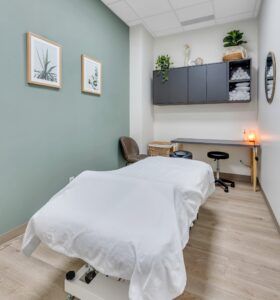How Can Massage Therapy Support Scar Tissue Healing after Breast Reduction: My Experience
Did you know that breast reduction surgeries are very common in Canada? They also boast a high satisfaction rate of 97% (Edgar, 2024)!

Breast reductions are typically done for people who want to reduce their breasts, typically by several cup sizes. It has a recovery time of around 6 weeks, but many patients can move comfortably after 2 weeks if they follow post-op care and do not engage in strenuous lifting. There are various incision types, including the T-type, anchor type and lollipop, but it depends on your breast size and which type your surgeon will decide on (HealthwiseStaff, 2022). In BC, if you have chronic back pain, it is often possible to seek a referral through your primary care provider, and it will be covered under MSP except for any added lyposuction, which is not covered.
Similarly, Top Surgery is a very common procedure and is done on individuals with breasts who want to have a flat chest. Though it is most common in trans masculine folks, there are cisgender men with different hormone levels who also go through a similar surgery to have a chest that fits their gender identity. For info on options regarding top surgery, please visit Chest reduction & construction | Trans Care BC.
Scar tissue massage can be helpful in a variety of ways. It helps soften and flatten scars, and does not let too much scar tissue build up in the area. Scars will continue to mature for twelve to eighteen months, so it’s best to start early and regularly practice your massage either at home or with the help of a massage therapist. Scar massage can also help reduce itchiness and over-sensitivity of scars. It also improves the flexibility and mobility of scars (University Hospitals Sussex, 2021).
I went through the recent experience of having a breast reduction. It has been a very positive experience overall. I felt like myself by the two-week mark and was lucky to have very little issues healing. Folks are often warned of possible scarring from the surgery; I didn’t know that it’s not just cosmetic but a complex internal tissue network as your body works to repair itself. Through this process, I also learned that you can meet with a knowledgeable massage therapist soon after your surgery, who can help support your healing process. Caitlin (she/they) is a Registered Massage Therapist. She has specific training in supporting those who have had upper surgery, breast reductions, and those with C-section scars. I met with Caitlin about four weeks after my surgery to assess how my scars were healing. She said that she had seen clients as soon as a week after either top surgery or breast reduction surgery. In these cases, they focus mainly on lymphatic drainage and often recommend dry brushing on all areas around the surgery site, not on incision sites, to get the body fluids moving as it begin to heal. While I had an experience with anchor-type scars done for breast reduction, Caitlin also offers C-section scar massage.
My experience at four weeks post-operation was smooth. At a follow-up appointment, I spoke with Caitlin about my healing. She asked if I had any spots that were bothering me or if I had major swelling left. She told me what to expect, and there was communication throughout the message. When speaking with Caitlin, she mentioned a few ways that she blends trauma-informed care into her practice of massage therapy. Ongoing consent with regular check-ins is how she first maintains client comfort, especially when working on sensitive areas such as a chest massage. There are always opportunities to ask questions before, after, and during. Finally, Caitlin treats everyone under the assumption they have trauma; she treats everybody the same, so it’s normalized and comfortable.
Many people don’t know how much clothing to take off before a massage. In this case, I could just remove my shirt and bra and lay them under the sheet. You can also leave your bra on if you are more comfortable or leave your surgical bra or sports bra on for extra comfort and support. The next step is to massage any adhesions of scar tissue developed as your body tries to heal itself. An adhesion is a band of scar tissue that joins two pieces of tissue that are not normally connected (used joined twice in this sentence). Your body is trying to heal; sometimes, it gets overzealous in building scar tissue and creates adhesions as it repairs wounds. Scar massage treatment after surgery can help break up these adhesions so you can heal more smoothly. The massage process was on and around my surgical scars using massage oil. Caitlin provided plenty of check-ins to make sure I was comfortable. Having your chest massaged can feel pretty vulnerable, especially after major surgery, so regular check-ins are part of trauma-informed care and are essential when seeking a therapist for this type of concern.
Overall, the massage process was a great addition to my healing journey. I felt like I learned much from Caitlin that was not covered in my surgery prep and post-operation discussion. I was better equipped to do self-scar massage at home, and it has greatly helped my healing process. If you have had surgery and want to get a scar tissue massage treatment, book in with Caitlin; you will be in good hands!
Sources:
Edgar, J. (2024, April 17). Breast reduction surgery: The ultimate guide: Realself. RealSelf.com. https://www.realself.com/surgical/breast-reduction
Healthwise Staff. (2022, April 13). Breast reduction. Breast Reduction | HealthLink BC. https://www.healthlinkbc.ca/health-topics/breast-reduction
MediLexicon International. (n.d.). Scar tissue: Causes, prevention, and treatment. Medical News Today. https://www.medicalnewstoday.com/articles/325753#causes-and-prevention
NHS Foundation Trust. (2020, March). Scars and Scar Massage.
Scar massage: A comprehensive guide. Gender Confirmation. (2024, January 30). https://www.genderconfirmation.com/blog/scar-massaging/ WebMD. (n.d.). Adhesions, general and after surgery. WebMD. https://www.webmd.com/a-to-z-guides/adhesion-general-post-surgery
Written by Odeya Yeoman (She/they), Masters of Counselling Psychology Student
